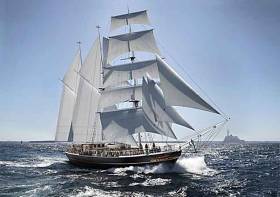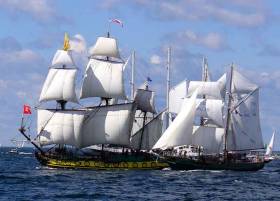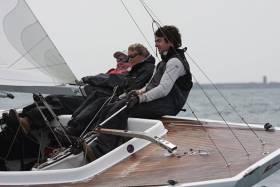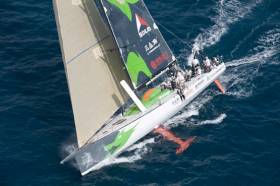Displaying items by tag: Atlantic Youth Trust
Atlantic Youth Trust Seeks Executive Administrator
The Atlantic Youth Trust is recruiting for an executive administrator to manage and optimise its day-to-day management and fundraising efforts.
The trust is a North–South youth development and cultural integration charity established in 2013 to connect youth with the ocean and adventure.
Currently it operates two tall ships and plan to take more than 560 youth to sea in 2024, together with shore-based activities and engagement.
The charity says its mission is to build life skills, resilience and co-operation in 15-to-22-year-old youths.
To support this, the trust is developing a strong volunteer network with local ‘chapters’, building a club of like-minded adults in the spirit of Irish excellence and adventure around the world.
The Atlantic Youth Trust is managed by AMX101, a philanthropic company, operating the registered charities in Northern Ireland (Reg CHY 106339) and the Republic of Ireland (Reg CHY 21079).
Reporting to the executive director of AMX101 Management, the executive administrator will have the following main duties and responsibilities:
- To manage and optimise the day-to-day administration, account management, support fund raising, events and to ensure effective communication
- To ensure strong financial controls, manage administrative compliance across the organisation and submit reports to relevant funders
- To support communications and information systems, website and social media platforms
- Financial ability, basic book-keeping, invoicing, banking, etc.
- Event management and supporting volunteer-led events
This is a full-time, Monday-to-Friday position based in Dun Laoghaire, Co Dublin with a salary range of €30,000–45,000.
To apply for this role, provide a CV and cover letter stating your suitability to the role and experiences ASAP to [email protected] by the closing date of Friday 26 April at 5pm.
Acclaimed Irish explorer and adventurer, Pat Falvey is to be honoured in Monaco next weekend when in the presence of HRH Prince Albert, he will be presented with the ATLANTIC Shackleton Global Award, supported by d’AMOCO Shipping,
The award, commemorating the great Irish Antarctic explorer Ernest Shackleton on his 150th anniversary, will acknowledge Pat’s many achievements, including being the first to lead an Irish team to the South Pole, climbing Everest from two sides, and having many other adventures.
Pat Falvey, a globally acclaimed explorer, motivational speaker, filmmaker, author, serial entrepreneur, and coach, hails from Cork City. Known as Ireland’s most celebrated adventurer, and was the first person in the world to complete the Seven Summits twice by climbing Mount
Everest from its north and south sides. He was the leader of the first Irish-led team to reach the South Pole and he has also stood at the North Pole. He led the first Irish team to ski across the Greenland Ice Cap and was the leader of the largest ever team to complete the South Georgia traverse, a journey made famous by heroic Irish explorers Ernest Shackleton and Tom Crean. Pat has led many other expeditions to some of the most remote and inaccessible parts of the planet.
"The award, commemorating the great Irish Antarctic explorer Ernest Shackleton on his 150th anniversary, will acknowledge Pat’s many achievements"
The Atlantic Shackleton Exploration and Adventure Global Award will be presented to Pat at a gala event in Yacht Club Monaco on Friday, April 19, in the present Prince Albert of Monaco. It is named after Sir Ernest Shackleton, who was one of the most world-acclaimed Antarctic explorers and was born in County Kildare 150 years ago this year. Shackleton led three expeditions to the icy wastes of the South Pole, most famously on board his ship, the Endurance. He was one of the most renowned explorers of the age of exploration.
“I am honoured to have been chosen for this award,” said Pat Falvey. “It is very prestigious and I’m delighted to accept it on behalf of the fact that I have followed in the footsteps of our great polar and Himalayan explorers.”
The Atlantic Youth Trust, a charitable foundation that aims to connect young people with the sea and with adventure, gives the award.
“Most of what Pat has achieved is a role model for the Atlantic Youth Trust and young people. Our mission is to connect youth with the ocean and adventure,” said Enda O’ Coineen, president of the charity.
The award itself is supported by d’AMICO shipping and is a globe that spins on both poles to show that the earth is comprised of 70% ocean. The Atlantic Youth Trust is a charitable organisation that works to connect young people with the ocean and adventure and is a North/South Body.
Tickets are still available at the ATLANTIC Monaco Gala Dinner with Prince Albert on 19th April here
Ireland’s Hopes for a Tall Ship Are Running High
What goes around comes around. When Enda O’Coineen’s Atlantic Youth Trust revealed their interest in acquiring a classic three-masted topsail schooner from Sweden last Autumn for multiple maritime functions, of which sailing training would only be one, it set bells ringing in many ways — most of them positive.
The warmest feelings were aroused by the classic appearance of the 164ft Lady Ellen. For the reality is that these days, the professional seafarers who undertake the demanding task of being responsible for the safety, well-being and instruction of dozens of other people’s children in sail training programmes are themselves expecting certain standards of onboard comfort.
In fact, the more fastidious expect accommodation which equals that provided for their colleagues serving in the best ships of the international merchant marine and the leading navies.
As a consequence, many modern tall ships are a very odd combination of classic clipper ship forward, and a sort of mini cruise liner aft. In some of them, this effect is achieved to such gross effect that it reminds you of the old saying that a camel is a horse designed by committee.
 She looks like a proper classic sailing ship, and sails like one too
She looks like a proper classic sailing ship, and sails like one too
But when the first photos were released in Ireland of the Lady Ellen, everyone just gave a happy sigh. Her sweet appearance may be slightly marred by a sort of wheelhouse shelter right on the aftermost pin of the quarterdeck, but otherwise her deck cabins are of modest height, with the overall effect being one of harmony.
And for those with memories stretching back over many years, the appearance of the Lady Ellen was like a friendly ghost brought to life, as she is a reminder of the hopes of two great sea-minded people who pioneered the idea of an Irish tall ship at a time when officialdom seemed determined to obliterate any consciousness of our maritime potential.
 The inspirational Arklow-based Lady of Avenel
The inspirational Arklow-based Lady of Avenel
One was Jack Tyrrell of Arklow, whose schoolboy summers as ship’s boy aboard his uncle’s trading brigantine Lady of Avenel were so central to the beneficial shaping of his character that his lifelong dream was to provide subsequent generations with the chance to share a similar experience.
The other was an inspirational teacher, Captain Tom Walsh, who ran the little Nautical College in Dun Laoghaire, and kept the flame of Irish maritime hopes alive in what was a very thin time for Ireland and the sea. One result of this was that in 1954, Jack Tyrrell designed for Tom Walsh some proposal drawings for a 110ft three-masted barquentine to serve as an Irish sail training ship.
 We’ve been here before: the 1954-proposed 110ft barquentine, designed by Jack Tyrrell for Captain Tom Walsh, is remarkably similar to the Lady Ellen
We’ve been here before: the 1954-proposed 110ft barquentine, designed by Jack Tyrrell for Captain Tom Walsh, is remarkably similar to the Lady Ellen
 By the summer, this could be the Grace O’Malley
By the summer, this could be the Grace O’Malley
 Captain Tom Walsh of the Nautical College in Dun Laoghaire – seen here in 1957 – was ahead of his time in sail-training ship proposals
Captain Tom Walsh of the Nautical College in Dun Laoghaire – seen here in 1957 – was ahead of his time in sail-training ship proposals
In the slow-moving 1950s, it was an idea before its time. And when Ireland did finally get a national sail-trailing ship in 1969, it was through a completely different route, with the repurposed Asgard, Erskine and Molly Childers’ 1905-built Colin Archer 51ft ketch used in the 1914 Irish Volunteers gun-running to Howth.
She was and is a fine little ship, now conserved by the National Museum and on display in Collins Barracks. But she was too small for the job, and very soon a movement was under way to have her replaced with a larger “mini tall ship”. In the February 1973 issue of Afloat Magazine, proposal drawings by Jack Tyrrell appeared of a ship inspired again by the Lady of Avenel, but of a more modest size at 83ft hull length.
By this time the sail training programme was in the remit of the Department of Defence, as it tended to be shunted around whichever government minister was interested in the sea — the choice was never extensive. But the newly-appointed Minister for Defence, Patrick Sarsfield Donegan TD of Co Louth, was keen on boats and sailing. He willingly undertook the Asgard programme. And he happened to see those plans one morning as he was starting to make a very thorough job of celebrating his saint’s day in his own pub, the Monasterboice Inn.
 Jack Tyrrell of Arklow with Clayton Love Jr, Admiral of the Royal Cork YC and one of the founders — and the longest-serving member — of Coiste an Asgard
Jack Tyrrell of Arklow with Clayton Love Jr, Admiral of the Royal Cork YC and one of the founders — and the longest-serving member — of Coiste an Asgard
Thus there is absolutely no doubt that the decision to build the 84ft Tyrrell-designed and Arklow-built Asgard II was taken by Paddy Donegan on 17 March 1973, but it was March 1981 by the time she was in commission.
She gave excellent service, punching way above her weight on the national and international scene for 29 seasons, until in September 2008 she struck a semi-submerged object in the Bay of Biscay, and gradually but inexorably sank, with all the crew being safely taken off.
With Ireland going into economic freefall in the total crash of the Celtic Tiger, the then Government — to outside observers, at least — appeared to take advantage of the situation to divest themselves of the entire notion of a national sail-training ship and a government-administered programme to support it. This was so abundantly evident that dedicated maritime enthusiasts came to the conclusion that the only way forward was through a non-governmental trust functioning on an all-Ireland basis, and thus the Atlantic Youth Trust came into being under the inspiration of oceanic adventurer and international entrepreneur Enda O’Coineen.
There are hundreds of subtly different meanings to the word “no”, but Enda doesn’t understand any of them. He is totally resilient in face of setbacks, be they in business or when he’s alone out on the Great Southern Ocean. And he is of the opinion that general derision or a flat refusal is actually — if the other party only knew it — a cheery greeting and a positive reception of whatever way-out idea he is proposing.
 Galway rules the waves: Enda O’Coineen with President Michael D Higgins
Galway rules the waves: Enda O’Coineen with President Michael D Higgins
Nevertheless, the Atlantic Youth Trust’s concept — developed by its director Neil O’Hagan to provide a ship partially based on the Sprit of New Zealand’s realised vision of a floating classroom and expedition centre as much as a sail training ship — was well received but difficult to grow in a time of national austerity, with political turmoil in the all-Ireland context.
But the idea had certainly never gone away, and while there are many reasons as to why it is now tops of the agenda once more. The fact that the Lady Ellen was for sale last September in western Sweden played a key role, with the excitement of the chase being heightened by the fact that it had been thought she’d been sold elsewhere.
 Stripped down for winter, the Lady Ellen in Sweden awaits her new future in Ireland
Stripped down for winter, the Lady Ellen in Sweden awaits her new future in Ireland
However, that seemingly fell through, she came back on the market, and now the deposit has been paid by Atlantic Youth Trust supporters subject to all the usual legalities and technicalities, such that if everything proves acceptable survey-wise and under other headings, the deal has to be closed by the end of February.
While she was built as long ago as 1980 for a Swedish industrialist with personal attachments to the prototype, the 1911-built wooden trading schooner Lady Ellen, the current ship’s hull is in top-grade steel as used for submarine construction, so not surprisingly she came through a 2015 survey and major refit with flying colours.
 This is one serious ship, built in submarine-quality steel to last for a very long time
This is one serious ship, built in submarine-quality steel to last for a very long time
Yet to the casual observer she seems to be all wood in her finish, and therein lies an extraordinary problem that will have to be faced by the AYT when, if all goes according to plan, the ship undergoes significant work with the Harland & Wolff shipyard in Belfast in the spring.
For her present accommodation is positively luxurious by sail training standards, though her seagoing credentials are impeccable with 17 transatlantic passages logged. Yet below decks, we’re talking of en suite cabins for around 35 in all, whereas the trust will be seeking to up the accommodation to at least 40 and probably 45 in all, with 30-35 trainees plus five experienced youth leaders and five professional crew.
 The existing accommodation details may need significant amounts of unravelling in order to accommodate a total ship’s company of 45-plus
The existing accommodation details may need significant amounts of unravelling in order to accommodate a total ship’s company of 45-plus
 The saloon — taking up the full width of the vessel — makes such extensive use of wood and varnish finish that you forget you’re on a steel ship
The saloon — taking up the full width of the vessel — makes such extensive use of wood and varnish finish that you forget you’re on a steel ship
 Even the “basic” crew cabin reflects the “problematically high” quality of the interior finish
Even the “basic” crew cabin reflects the “problematically high” quality of the interior finish
When Jack Tyrrell was sketching out the accommodation for the Tom Walsh ship of 1954, he simply indicated space where the crew’s sleeping accommodation would be found. He may well have expected that the young people would be happily slinging a hammock from the deck beams.
But as the photos of the current ship indicate, while not totally luxurious, her accommodation is stylish, very well finished, glowing with the best of varnish-work, and generous with space. So some of it will have to come out, and we can only hope that it’s treated a little more kindly than the bits and pieces of the original Colin Archer interior for Asgard which, in 1968 when she was being converted for sail training by Malahide Shipyard, were brutally consigned to a bonfire.
 The separate cabins emphasise the high quality of the finish
The separate cabins emphasise the high quality of the finish
With repurposing all the rage these days, some of the ship’s current accommodation could certainly find some interesting and useful functions ashore, or in other boats. But the fact is while the vessel is being bought reportedly for the attractive price of €1.78 million, unbuilding and rebuilding can be an expensive process, as can the necessary replacing of standing and running rigging, and perhaps some spars.
Thus, if all goes according to plan with the deal closed at the end of February, the current project of getting the ship in commission in her new form, with the necessary shoreside support systems up and running, will be very rapidly making significant dents in the overall budget of €3 million.
And we have to remember that while the gallant Asgard II succeeded in punching above her weight among much larger tall ships, this new vessel is twice as long overall, making her in volumetric terms very much more than simply twice as large. So it’s going to take a considerable and constant effort to keep her in optimal trim and at full functional level. For apart from anything else, a busy ship is a happy ship, but a 164ft three-masted topsail schooner is a lot of ship to keep busy.
Yet the very fact that the Grace O’Malley, as she’ll be popularly renamed, has now come centre stage is just the tonic that we all need at this time of tiny slivers of hope, when it’s just possible the light at the end of the tunnel is not entirely a total pandemic express train coming the other way. We wish her well.
 She’ll be even more welcome than the flowers in spring – the Grace O’Malley may be coming to a port near you
She’ll be even more welcome than the flowers in spring – the Grace O’Malley may be coming to a port near you
There is progress for sail training in Ireland with the “generous offer” of a potential tall ship, the Minister for Defence has acknowledged.
Dún Laoghaire Senator Barry Ward today (Thursday 14 October) raised the matter with the Minister Simon Coveney and emphasised the importance of funding for a new sail training vessel in Ireland to replace Asgard II.
Senator Ward also outlined the importance of sail training for people from diverse communities throughout the island of Ireland.
“Sail training is a really important vehicle to introduce people to the marine sector as a sporting and employment opportunity for them,” he said. “Asgard II provided generations of Irish people with a chance to experience sailing and being out on the sea in a way that they never normally would.
“Since Asgard II sank in 2008, there has been a gap in sail training in Ireland. It is high time that we put proper sail training back on track with a new tall ship, to allow people of all backgrounds to get on the water, to build a connection to the sea, and to feel what it is like to be on the sea all around this island.”
Paying tribute to the Atlantic Youth Trust — which has identified a 164ft schooner which could be used as a sail training vessel and is currently for sale in Sweden, as previously reported on Afloat.ie — Senator Ward called on the minister and the Government to commit to proceeding with this vessel as a new sail training vessel for Ireland.
Responding to the senator, Minister Simon Coveney stated his commitment to the project and confirmed that there was a generous offer in terms of the proposed tall ship.
Minister Coveney said that the Government is “supportive of the principles of a sail training programme”, that officials had met with the Atlantic Youth Trust yesterday (13 October) and that funding for sail training through Sail Training Ireland will be provided in 2022.
Senator Ward added: “Ireland is an island country and we need to build opportunities for young people to be connected with the sea.
“This is a real opportunity for Ireland to put itself back on the sail training map with a vessel that will operate as a sail training vessel but would also be available for research, innovation, diplomacy and a range of other facilities to the State.”
Tall Ship Youth Training Vessel Requires Urgent Reinstatement of State Funding - Atlantic Youth Trust
Youth development, education and cultural charity the Atlantic Youth Trust have made a direct appeal to An Taoiseach, Micheál Martin TD and Minister Simon Harris TD, to reinstate the €950,000 which came from the National Lottery to support the operational costs of a new tall ship for Ireland. The charity made the call against the clear commitment in the Programme for Government to develop Ireland’s ocean wealth, sustainability, and the environment.
As Afloat reported earlier, the group says it has identified a ship to replace the lost Asgard II. The ship, the trust says, will act as the new ‘flagship’ for introducing young people across the island of Ireland to maritime and careers. In addition, it will have a key role to play in the areas of research, innovation, tourism promotion and providing a support outlet for vulnerable young people.
 Chair of the Atlantic Youth Trust, Enda O'Coineen
Chair of the Atlantic Youth Trust, Enda O'Coineen
Chair of the Atlantic Youth Trust, and former Director of Coiste an Asgard, Enda O’Coineen was introduced to the ocean and adventure on the original Asgard. He advocates for how this opportunity changed the course of his life and is joined by a high-level group of youth workers, people in business and academics behind the project. Commenting Mr O’Coineen said: “With a large research-led support base, we have long since championed for the need to replace Ireland’s lost sail training vessel the Asgard II in a dynamic and creative new way.
“This would be a strategically important move for ensuring we are well-positioned to maintain our island’s rich maritime heritage, skill set and knowledge. This will be vital for connecting future generations with the ocean and adventure who might normally never get the opportunity. As we emerge from the Covid 19 pandemic, the urgency for supporting projects like this has never been more important as we seek to address growing mental health challenges facing our young people.”
In looking for a solution to this, the Atlantic Youth Trust has identified, a 164ft Tradewind schooner lying in Sweden which is an ideally suited replacement for delivering youth maritime development and sail training.
 The 164ft Tradewind schooner lying in Sweden
The 164ft Tradewind schooner lying in Sweden
The ship is to be renamed the Grace O’Malley, after the so-called Mayo ‘Pirate Queen’. Built of steel in a modern structure, and elegant lines of a 19th century Tall Ship, she is considered fit for purpose to high safety specifications.
Mr O’Coineen added: “In our recent pre-budget 2022 submission to the Office of An Taoiseach and other Government Departments, we called for the reinstatement of an annual Government subsidy to assist with the day-to-day operational costs of a new vessel.
This funding was previously channelled through the National Lottery. Given the strong training and education remit planned for the new vessel, we believe it’s pertinent that Government funding, if reinstated, is directed via the Department of Further and Higher Education, Research, Innovation and Science, under Minister Simon Harris.
“To support our pre-budget submission, we also included a comprehensive business proposal outlining how the purchase of the identified successor ship will be funded through private and philanthropic sources. This can only happen if the State commits to reinstating the former Asgard II National Lottery funds to support the new ship’s operations budget. We believe the reinstation of these funds would go a long way in supporting a clear commitment made in both the Programme for Government and the Ocean Wealth Strategy to develop Ireland’s ocean wealth, sustainability, and the environment, integrated through the National Marine Co-Ordination Group”
In addition, the Atlantic Youth Trust are seeking a once-off commencement grant from Government of €880,000 to support refit costs, ensuring the ship is fit-for purpose with disabled access as well as the establishment of an organisation to run the ships operation. This commencement budget would represent approximately 20 per cent of the insurance funds retained by the State when the Asgard II was lost.
Head of the National Maritime College of Ireland and Atlantic Youth Trust advisory board member, Cormac Gebruer said: “To have a tall ship back in Ireland repurposed to introduce our younger generations to the maritime would be a significantly important and strategic development for the College. There are huge opportunities to utilise this initiative for research purposes linking in with human behaviour and marine sciences which would complement the work we are doing here in the College.
“The Atlantic Youth Trust has been an exemplary resource in leading a world-class solution for youth development integrated with the maritime across Ireland together with its focus on research and partnering with other colleges, such as NUI Galway. We at the National Maritime College of Ireland very much support the endeavours to secure a suitable replacement tall ship training vessel following the loss of the Asgard II.”
As Afloat reported at the time Asgard sank off the French coast in 2008. More details on the background to the sinking, campaign to raise and then replace her are in Afloat's dedicated Asgard II section
Co-founder of Sailing into Wellness and Atlantic Youth Trust advisory board member, James Lyons said: “Following a recent visit to Sweden to see the proposed successor ship in lying, I’m convinced that she will fire people’s imagination if brought to Ireland renamed as the Grace O’Malley. Built with submarine steel to the highest specifications and modelled on a classic wooden tall ship, she will make an ideal tall ship for Ireland with some small modifications.”
Once the Irish Government commits to the reinstatement of the Asgard II funding, additional financial support for the project will then be sought from the Northern Ireland Executive, with the initiative marked as a North-South venture. It’s envisaged that the ship will act as a fantastic promotional platform for tourism, enterprise, culture and the marine across the island of Ireland.
Chair of Tall Ships Belfast 2009 & 2015 and Atlantic Youth Trust advisory board member, Dr Gerard O’Hare said: “While there is an onus on the Irish Government to honour its commitment to supporting the maritime through the reinstatement of the Asgard II funding, there is also scope to seek support from the Northern Irish Executive once the project is up and running. This could include part-funding the initial fit-out planned for early 2022 in Belfast.”
€15,000 for Atlantic Youth Trust Bursary
In a historic first for the Atlantic Youth Trust, €15,000 has been donated in the memory of Adrian Ryan in order to provide 15 years of bursaries for young teens who ordinarily would not have the opportunity to access youth development tall ship voyages.
The generous donation was facilitated by Adrian’s brother Joe Ryan, retired Irish Coast Guard official, following the sale of a beatiful Ford RS 2000 that his brother Adrian had been restoring prior to his passing earlier this year.
Speaking about this donation Joe Ryan said: “I have been a long supporter of the Atlantic Youth Trust and for me and my family the thought that Adrian’s memory will live on for the next 15 years is heartwarming. Spending time at sea as a teenager can have a profound impact on a young person's life.”
The Bursary stipulates that €1,000 will be made available for a teenager from a city centre school in Dublin or Belfast under the ‘Adrian Ryan Bursary’. Adrian and Joe both attended C.B.S. Westland Row and it is hoped that students from that school will benefit in the years ahead. This will allow for approximately 10 days of voyaging per annum, over the coming 15 years.
Atlantic Youth Trust’s Neil O’Hagan added: “The long term sustainability of any youth development tall ship trust is in its ability to provide access for all young people regardless of means or ability. In order to do so financial support is essential whether it be public funds, private, philanthropic, corporate or legacy donations.”
“This incredibly generous donation and the ‘Adrian Ryan Bursary’ is the first of its kind for the Atlantic Youth Trust. We hope, as is the case with many charities close to people's hearts, that it will be the first of many.”
Both the Irish and Northern Irish Government’s have formally committed to the Atlantic Youth Trust’s plans for a new tall ship to be run along the same structure as the highly successful Spirit of Adventure Trust in New Zealand. Prior to the new vessel being commissioned, the bursary will be used to place youths on other ships.
Back in June I asked if there was sufficient joined-up thinking about the project for a new Irish tall ship – and why the Naval Service hasn’t taken a more active role in Irish sail training over the years, with advantages to itself, comparable to what the Royal Navy does in Britain…you can read that story here.
Neil O’Hagan, Executive Director of the Atlantic Youth Trust, organisers of a new national tall ship project, sent me an email saying that it is good to see discussion about the project so that it gets attention… but that “there is more going on than meets the eye…”
On this week’s Podcast, I indicate that I am glad to hear that, but I have reservations and will be convinced about actual Government support when I see it delivered…
Listen to the Podcast below…
A New Tall Ship For Ireland? Would it Be Worth The Trouble?
As we move into March each year, throughout Ireland Tall Ships enthusiasts will wistfully recall that it was in March 1981 that Ireland finally commissioned her own Tall Ship, a national flagship worthy of our aspirations, the Jack Tyrrell-designed and Arklow-built 84ft brigantine Asgard II writes W M Nixon.
She gave years of excellent service and introduced young people from all backgrounds and every part of the country to the complete sail training experience at its very best. Yet although she was officially within the remit of the Department of Defence, in times of government expenditure cutbacks, the very existence of such an exotic creature in the amidst the workaday problems of running organisations with a military emphasis could be problematic.
Under a succession of talented and dedicated skippers with a small but devoted permanent crew, Asgard II was run in an efficient yet distinctly non-military, non-bureaucratic way. Even if at times it was done on a shoestring, it was all kept working, appearances were kept up with the vessel maintained by the crew, and the seemingly free-style system of command, while it had a core of disciplined pure steel at its heart, worked well to create a happy ship.
Nevertheless it could be argued that the unique and complex problems of running a small national sail training ship and her programme were about as far as could be from the instinctive abilities and traditional approach of the Irish Public Service mindset. But that said, the Irish public service has broad shoulders. There may not always have been total enthusiasm within it for having anything to do with running Asgard II. But it was always there in their In-tray, and they got on with it, with secretaries to Coiste an Asgard tending to give service way over and above the requirements of duty.
Yet being a Government-run ship, inevitably the viewpoint of whoever was Minister for Defence at the time affected the attitude to the Asgard programme. The realities of democracy intervened. At a national level, even in coastal constituencies, few if any votes were won or lost over whether the local TD vociferously supported the Asgard II sail-training programme. And if the current Minister for Defence happened to represent an inner-city constituency with little if anything in the way of deeply-engrained maritime traditions, Asgard II was way down the list of priorities.
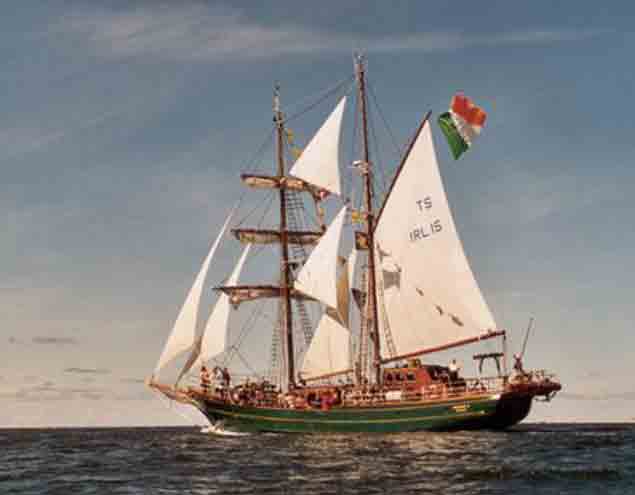 Thanks to devoted bos’uns and crew, Asgard II was always looking her best even when age was creeping up on her.
Thanks to devoted bos’uns and crew, Asgard II was always looking her best even when age was creeping up on her.
But she could be kept going – just - thanks to the ability of those running her to stretch resources to the limit and beyond. Yet with every passing season, the longterm problems were increasing. By the time she was sailing her 25th season in 2005, there were those who argued that a traditional wooden hull, with its single-skin planked construction, was no longer in compliance with increasingly complex regulations which required double-skin construction in a passenger-carrying boat, but Asgard II – with her limited number of trainees - was still able to pass regulations as a cargo-carrying vessel.
Then too, in the late noughties, Asgard was looking her very best with a devoted skipper and an extremely able bo’sun. But skilled painting, word-class varnishwork, and the necessary provision of a new and highly-visible set of immaculate spars, disguised the fact that if Coiste an Asgard had been given the funds to provide a replacement hull, the latest set of regulations would have insisted that it be double-skin. That in turn would have led to a raging public debate between those who would insist that Asgard III must be built in wood, and those who would reasonably point out that a double-skin wooden hull – with a safety gap between the skins as required by regulations – would be very space-consuming in a little ship which, even in her single-skin version, was already very crowded within her hull, and thus steel or even aluminium would provide the best way to go.
It all became very academic on September 8th 2008, when Asgard II sank off Belle Ile in the Bay of Biscay while on passage with a full crew of trainees from Falmouth in Cornwall towards the French port of La Rochelle. It started to happen shortly after midnight, and as she sailed along in reasonably pleasant late summer conditions, no-one on board had seemed aware of any impact with a submerged hazardous object, such as a container, which might have caused this sudden ingress of water.
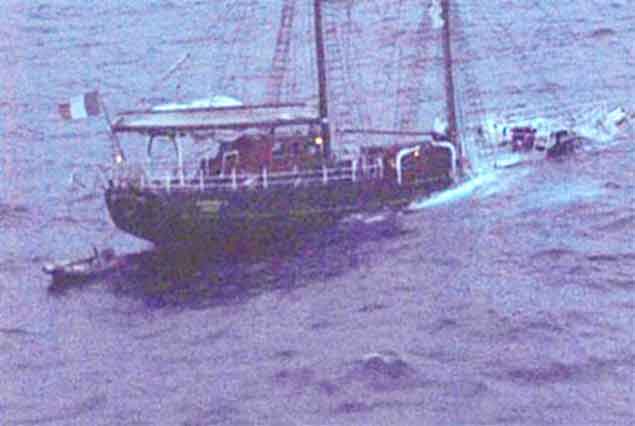 Monday, September 8th 2008
Monday, September 8th 2008
But it became such that the ship’s pumps couldn’t cope, and the captain’s first duty was to his trainees – it would have been irresponsible to spend precious time in the small hours of the morning calling up any ship which might happen to be in the neighbourhood, in the hope that she might have transferrable pumping systems which would have helped alleviate the problem.
The seamanlike thing was to declare the ship a hulk, and arrange her abandonment in an orderly manner. The only setback which arose in this action was the collapse of the floor in one of the large liferafts – a liferaft which had only recently been re-certified – but the people on it were transferred to other liferafts, and in due course the local lifeboat arrived and took everyone to Belle Ile while Asgard sank with a certain quiet dignity, and took up a position sitting on the seabed in 84 metres of water.
There were immediate calls for her salvaging as soon as possible, to be followed by full restoration and a resumption of sail training duties. But the senior officer of the Naval Service involved in the issue put it all in a harsh but necessary perspective: “Would you like your children to go to sea as trainees in a ship which has sunk in this way” he quietly asked, “when, however good the restoration, it is still the restoration of a vessel which inexplicably sank like this?”.
For however much you try to read into the official report, its results are not totally conclusive, and the reality is that the Asgard II sank, and sank quite quickly, after an impact of which no-one was aware. It’s very likely the sinking would not have happened had she been double-skinned. But any attempts to make a raised and restored Asgard II into a double-skinned vessel would have been an absurd waste and misdirection of resources.
Be that as it may, by this time, the Irish economy was in complete free-fall off a very high and steep economic cliff, and although the loss of the Asgard II was assuaged eventually by an insurance payout of €3.8 million, it was only within the sail training community that anyone protested against the transfer of these funds to the Department of Finance at a time when the national economy was on its knees with the Troika bail-out.
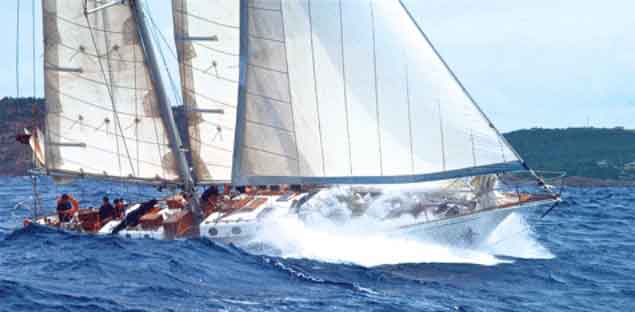 Spirit of Oysterhaven is licensed to carry 12 trainees
Spirit of Oysterhaven is licensed to carry 12 trainees
In fact, the Government – for the time being at any rate – was quietly exiting the sail training arena, and in 2011 all the remaining assets and functions of Coiste an Asgard were transferred to a new non-Governmental organisation, Sail Training Ireland, which set to work to find berths for Irish trainees on other ships in an international network which, partly thanks to the very favourable reputation which Asgard II had established for herself during her 28 busy years, has been working well as they’ve also brought in “private enterprise” training ships such as Oliver Hart’s yacht-like 70ft schooner Spirit of Oysterhaven, which has been awarded the Sail Training International Small Vessel Award for 2016, a really notable achievement in a crowded field.
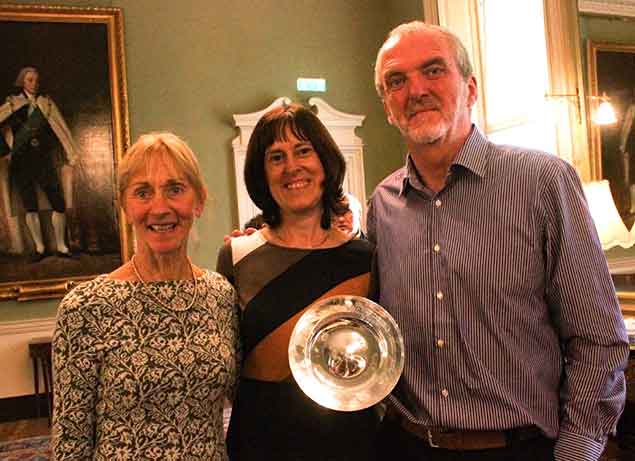 Kate Hart, Sinead Hurley and Gary Davis of Spirit of Oysterhaven. Winner of Sail Training International Small Vessel Award for 2016.
Kate Hart, Sinead Hurley and Gary Davis of Spirit of Oysterhaven. Winner of Sail Training International Small Vessel Award for 2016.
 While sail training should be mainly about sailing, from time to time the vessels involved have to manoeuvre under power in very small harbours. Spirit of Oyserhaven’s lines are of special interest, as they reveal the designer has retained a straight leading edge on the rudder, thereby optimising the control benefit of propeller thrust even though the propeller is in an aperture in the long-keel hull.
While sail training should be mainly about sailing, from time to time the vessels involved have to manoeuvre under power in very small harbours. Spirit of Oyserhaven’s lines are of special interest, as they reveal the designer has retained a straight leading edge on the rudder, thereby optimising the control benefit of propeller thrust even though the propeller is in an aperture in the long-keel hull.
But inevitably a couple of years after the loss of Asgard, when her complete demise was finally accepted, voices were being raised in support of returning some day to the position of Ireland having her own sail training ship. It has to be said that these were for many years just a few voices crying in a wilderness, for in the near decade since Asgard II sank, Ireland has been a complete disaster area for tall ships and sail training vessels.
The litany of disaster is unbelievable. The only redeeming feature is that in a great tapestry of sinkings and groundings and the striking of rocks, not one life has been lost. But many dreams and careers have been utterly destroyed.
Appropriately, we’d had a rehearsal on RTE way back in 2003, when the traditional gaff schooner Carrie involved in the reality TV series Cabin Fever managed to come ashore on Tory Island, and soon broke up for the delectation of millions of viewers worldwide, with the whole sorry episode being on a loop on the screen in many a harbourside bar.
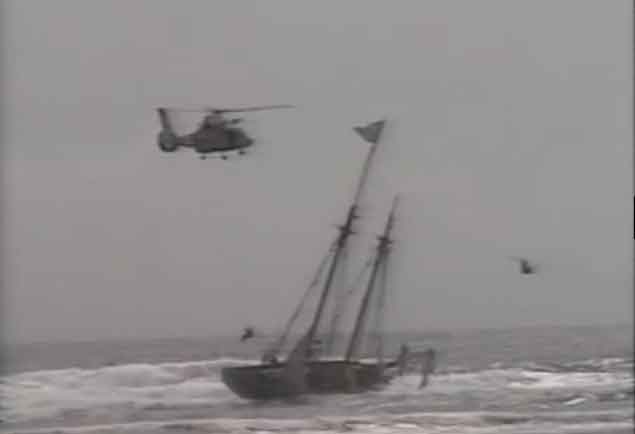 A video grab from RTE News of the Cabin Fever Ship aground
A video grab from RTE News of the Cabin Fever Ship aground
Then, even before the Asgard II story had been laid to rest, in 2010 the Northern Ireland Sail Training ship, the 80ft Oyster ketch Lord Rank, managed to impale herself on a rock northwest of Ballycastle in Rathlin Sound on the Antrim coast. Once again the incident got even more publicity than would have normally been expected, as they had a team from Downtown Radio on board to transmit a broadcast.
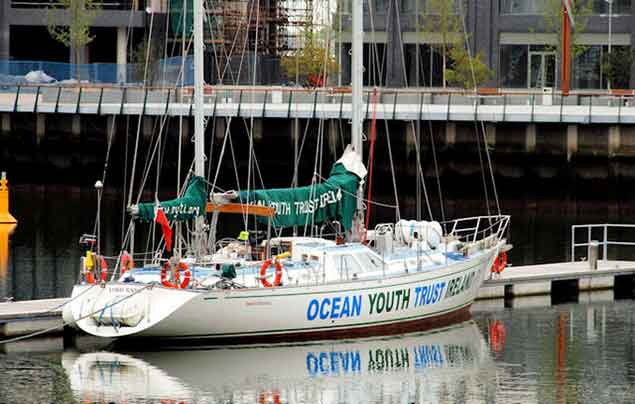 The Northern Ireland 80ft ketch Lord Rank sank within two years of Asgard II going down
The Northern Ireland 80ft ketch Lord Rank sank within two years of Asgard II going down
But a Bermudan rigged ketch on an isolated rock doesn’t make for nearly as spectacular a wreck as a proper Tall Ship destroying herself in against a cliff, and this epic was provided in 2013 when it was demonstrated that the road to hell is paved with good intentions.
Ireland was barely getting her nose above water after the bail-out, and in order to get things moving again on the tourism front – for who would want to be a tourist in a country in the depths of economic and psychological depression? – the Department for Tourism set up 2013 to be the Year of the Gathering, when people of Irish descent worldwide would be encouraged to return home for holidays in the Old Sod, the land of their ancestors.
Whether it was a bright idea or not is neither here nor there, as funds were lapped-up in order to pay for “Gatherings” such as family weddings. But the fact is that generally it was announced with little enough time to spare for anyone, other than those catering for people who make last-minute short-break holiday decisions, to make proper plans. Thus with only months to go, the Irish Sailing Association co-opted the Cruising Association of Ireland to put together a Gathering Cruise for visitors from Dublin Bay to West Cork, and while it attracted a turnout, the mood became more optimistic as they proceeded along the south coast, as it was learned that at Oysterhaven the little fleet would be joined by the 137ft Dutch Tall Ship Astrid, which at a stroke would maybe double the number of people taking part.
But the Irish weather and the fates in general would not let you get away with such a serendipitous turn of events. Following the Oysterhaven meet, the fleet were to parade round to Kinsale. But it was a dirty day of an onshore wind, and the old Astrid would need the help of her small auxiliary engine if she was going to make a suitably impressive entrance to Kinsale close by the cliffs.
Unfortunately, at a port of call earlier in her voyage from the Netherlands, Astrid had mistakenly had some fresh water put into her diesel tank. Though every effort had been made to remove it, the fuel was still contaminated and the engine cut out at the absolute crucial moment of rounding the headland immediately east of Kinsale.
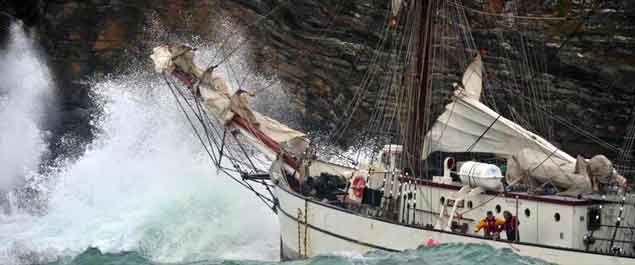 Death in slow motion. Astrid onto the cliffs outside Kinsale
Death in slow motion. Astrid onto the cliffs outside Kinsale
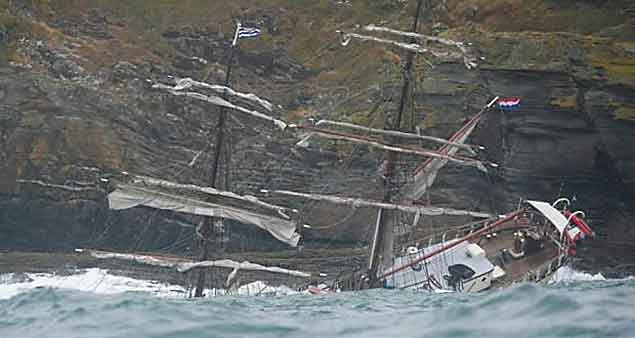 All hope gone. Astrid’s death throes.
All hope gone. Astrid’s death throes.
Unlike the Asgard II’s graceful departure, poor old Astrid had a long and lingering death in against those cliffs. It was a salutary lesson for everyone, for until then we’d tended to look to the Dutch as the very exemplars of a properly-run, indeed closely-regulated maritime nation. Yet it emerged that neither Astrid nor some of those involved in running her were properly certified to be taking trainees to sea.
We’re always told that we in Ireland are too lax in implementing European maritime law, working on the old Chinese saying that the mountains are very high, and the Emperor is far away. Admittedly, apart from Snowdonia in Wales, there are no mountains between Ireland and Brussels. But even so, things seem to be the other way round in any case – the nearer you get to the entre of power, the more relaxed is the observation of “petty” regulations.
In 2013 I’d already seen a demonstration of this when a large Dutch contingent arrived in Dublin as part of the Old Gaffers Association Golden Jubilee Cruise in Company. When we were in Dublin port, up the river came a Dutch character boat captain and his little dog in their tiny dinghy, and a classic Seagull outboard on the stern spluttering all sorts of pollution at a time when everyone else in Europe seemed obsessed with the compliance of regulations about changing to much heavier pollution-reducing four strokes, or making the big move to electric outboards.
 One man and his dog. In 2013, a Dutch Old Gaffer cruising the Liffey had scant regard for Directives from Brussels about doing away with old polluting outboards. But at least they were wearing lifejackets…..Photo: W M Nixon
One man and his dog. In 2013, a Dutch Old Gaffer cruising the Liffey had scant regard for Directives from Brussels about doing away with old polluting outboards. But at least they were wearing lifejackets…..Photo: W M Nixon
So all is not as it seems at the heart of Europe. And after the Astrid disaster those who might have though of using the highly-regarded Dutch marine industry as the source of a new vessel had to undertake further research until they were once again certain it was still the right thing to do.
But equally, after the loss of the Carrie, the Asgard II, the Lord Rank, and the Astrid, and after it had emerged that it was simply too costly to keep the Jeannie Johnston in Dublin and the Dunbrody in New Ross in certified condition as seagoing tall ships, instead of just using them as permanently-berthed visitor attractions, there inevitably has emerged a quiet but real body of opinion which reckons that Ireland having the luxury her own sail training tall ship simply isn’t worth the hassle.
 The Dutch ship Morgenster. Should we continue to send her a regular supply of trainees to save ourselves the trouble of running our own tall ship?
The Dutch ship Morgenster. Should we continue to send her a regular supply of trainees to save ourselves the trouble of running our own tall ship?
After all, Sail Training Ireland – now with Darragh Sheridan as CEO after Michael Byrne has moved on to fresh fields after several successful years – is running very smoothly in placing trainees in other European ships, with the Dutch vessel Morgenster in particular proving so popular that she is now almost honorary Irish.
As the STI programme has developed, well-wishers and organisations such as the Irish Cruising Club are finding it an attractive propositions to provide bursaries for young people to go to sea in a proper international tall ships situation through the STI’s current setup. It’s neat, tidy and manageable. And when winter comes, it’s not our concern whether or not the Morgenstern, and other ships that we in Ireland use, such as the splendid Europa, have to undergo a major refit or instead get themselves out to the Canaries for a profitable winter programme.
Thus as ever it was heartening to attend STI’s annual awards ceremony in Dublin’s Mansion House, and share the enthusiasm of an enormous diversity of young people each of whom had responded in their own favourable way to the Tall Ships experience.
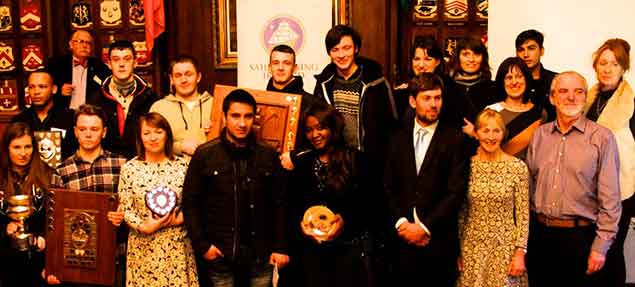 All the award winners at this year’s Sail Training Ireland ceremony in the Mansion House.
All the award winners at this year’s Sail Training Ireland ceremony in the Mansion House.
 Presentation of the Cork Life Centre-Asgard Award with (left to right) Sara Mason & Daragh Sheridan of STI, MC Marcus Connaughton, Commodore Hugh Tully, Flag Officer Commanding Naval Service, and Dublin City Councillor Ruairi McGinley presenting the award to Stuart Barry, Danny O’Keeffe, William Cooper, and Colm O’Brien
Presentation of the Cork Life Centre-Asgard Award with (left to right) Sara Mason & Daragh Sheridan of STI, MC Marcus Connaughton, Commodore Hugh Tully, Flag Officer Commanding Naval Service, and Dublin City Councillor Ruairi McGinley presenting the award to Stuart Barry, Danny O’Keeffe, William Cooper, and Colm O’Brien
 Nathan Howard (left) representing Tim Baker of Belfast, the awardee for Outstanding Achievement, with Seamus McLaughlin, Chairman of Sail Training Ireland
Nathan Howard (left) representing Tim Baker of Belfast, the awardee for Outstanding Achievement, with Seamus McLaughlin, Chairman of Sail Training Ireland The STI Outstanding Contribution award goes to Victor Springbok (right) with (left to right) Sara Mason & Daragh Sheridan of STI, Commodore Hugh Tully and Cllr Ruairi McGinley
The STI Outstanding Contribution award goes to Victor Springbok (right) with (left to right) Sara Mason & Daragh Sheridan of STI, Commodore Hugh Tully and Cllr Ruairi McGinley
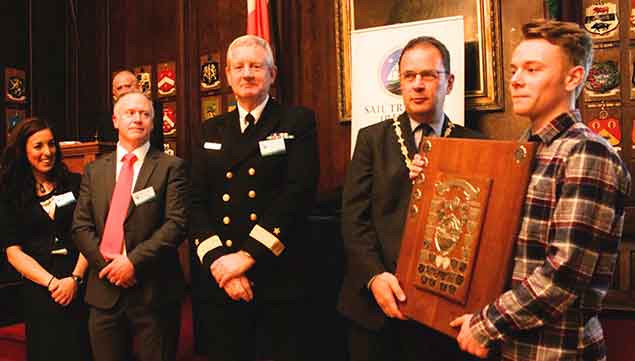 STI Trainee of the Year Ross Moore (right) with (left to right) Sara Mason, Daragh Sheridan, Commodore Hugh Tully, and Cllr Ruairi McGinley.
STI Trainee of the Year Ross Moore (right) with (left to right) Sara Mason, Daragh Sheridan, Commodore Hugh Tully, and Cllr Ruairi McGinley.
But then you couldn’t help but notice that in the Mansion House a popular guest, to whom everyone seemed to relate, was Neil O’Hagan, of the Enda O’Coineen-inspired Irish Atlantic Youth Trust. Their purpose is the creation of an all-island Irish Sail Training Ship, a 140ft three-masted barquentine based on the proven Spirit of New Zealand, and built in steel in the Netherlands by reputable designers and builders, while keeping open the option of having her builders provide a kit which can then be assembled here to become a ship built in Ireland.
To work, the project would need a considerable level of Governmental input and in Ireland’s always fluid yet somehow also rigid political situation, that is the Great Unknown. The Atlantic Youth Trust has offices in Dublin and Belfast to deal directly with Government even if the island’s real maritime capital is Cork, but resolving that will be another day’s work.
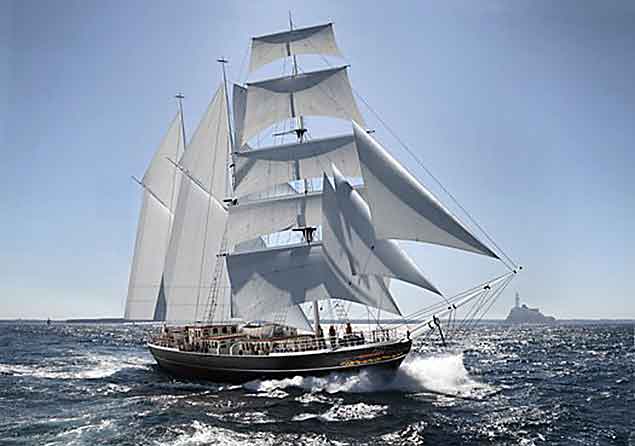 The vision. Concept image for the barquentine-rigged 40-metre Tall Ship proposed by the Atlantic Youth Trust
The vision. Concept image for the barquentine-rigged 40-metre Tall Ship proposed by the Atlantic Youth Trust
As it is, thanks to the influence of leaders such as Chairman Lord Glentoran, the Atlantic Youth Trust arranged a meeting with Peter Robinson MLA, the then First Minister of Northern Ireland. A Tall Ships gathering was shaping up in Belfast (when it happened, it was a notable success) so the mood was good for the delegation, and the First Minister warmly received the idea of a concept which would inevitably involve Government capital expenditure.
And then he made one request. He asked them to go along the corridor and put the idea to Deputy First Minister Martin McGuinness MLA, as that was the way shared power was meant to work. So along they went in some trepidation, and after the usual introductory pleasantries, they outlined the situation and were almost bowled over by Martin McGuinness’s enthusiasm.
Eventually, when they were taking their leave, they asked him why he had leapt at the idea so keenly. He replied that apart from it being a very good idea, it was maybe the first clearcut occasion on which the First Minister had received a proposal, and then without the usually inevitable closeting with his special advisors, had immediately given it a fair wind along to the Deputy Minister. It was how power-sharing was meant to work, but very rarely did.
It was a good start, but there was still a long way to go, for in tandem with their negotiations in the north they had to bring the Dublin government in as an equal partner. Here, the overall response was favourable but the complexities – involving a different structure of Government departments, not to mention all the movements in political mood - made it long hard going.
Meanwhile, there was a by-product which bears out the effect they’d had in the corridors of power in Stormont. Our northern correspondent Betty Armsrong was in Derry for the visit of the Clipper Fleet, in which the city had an entry, and came back enthusing about her new VBF Martin. It turned that while in the Maiden City, she’d spent some time in the company of Martin McGuinness whose enthusiasm for the entire waterborne pageant was total. “Admittedly” said he “the cost of supporting the boat and getting the visit seemed very high when we were being talked into this, but now that it is happening so well, it’s worth every penny”.
It would be ironic if the successful visit of the Atlantic Youth Trust to the office of the Deputy First Minister is in the end only recalled for the fact that Martin McGuinness was an increasingly enthusiastic supporter of major maritime events and projects. But the reality in Government is that the political personnel landscape is now entirely changed both north and south, and we’ll need the dust to settle before we can see where it’s all going.
Yet even as recently as November, Neil O’Hagan reckoned things were looking good, and he’s convinced they’ll come good again in due course. Back in November, despite the turbulence of Brexit, he was getting various government departments north and south and the STI and other bodies nicely lined up for a series of test programmes using the Morgenstern, and then anticipated building on that. A plateau of achievement had been reached, and former Olympic Gold Medallist Lord Glentoran, a visionary chairman but now well into his eighties, felt the time was right to step down and be replaced by noted businessman and experienced sailor Peter Cooke.
 Atlantic Youth Trust in Belfast with (left to right) Neil O’Hagan, Lord Mayor of Belfast Brian Kingston, incoming AYT chairman Peter Cooke, President Enda O’Coineen, and outgoing chairman Lord Glentoran.
Atlantic Youth Trust in Belfast with (left to right) Neil O’Hagan, Lord Mayor of Belfast Brian Kingston, incoming AYT chairman Peter Cooke, President Enda O’Coineen, and outgoing chairman Lord Glentoran.
But since November, other things have happened. The collapse of the Stormont administration and the General Election last Thursday will have its effect. So will the possible changes of leadership south of the border. And while Enda O Coineen now has a largely honorary role in the Atlantic Youth Trust as President, public perception is so febrile that we can only guess at the effects – favourable or otherwise – his major setbacks and his courageous handling of them in the Vendee Globe race will have on the way people view the Atlantic Youth Trust.
Thus for the moment there’s a distinct vacuum where positive progress towards a joint-government-underwritten sail training ship for all Ireland might normally be found, and all too quickly, vacuums being what they are, all sorts of alternative solutions may be offered.
The trouble is that, when faced with a big traditional sailing ship and better still a square rigger - any square rigger, and preferably one with a magnificent clipper bow – people will lose the run of themselves in dreams. Dreams of sailing the seas as the great mariners of yore did before them. Dreams of introducing young people to the wonders of sail. Dreams of saving the planet through the healing effects of majestic rigs driving non-polluting tall ships cross the ocean.
Such dreams are getting thing entirely the wrong way round. Certainly you may be inspired by seeing a ship like the Europa making her handsome way down Befast Lough under full sail. But having seen her, that’s when the research work should start, the hard work behind the scenes to make it all a realistic proposition, and start working towards sustainable funding.
Yet it so easy to see the ship and get inspired and immediately involved without a thought for what it will cost in the long run. That’s probably how the elderly owner of the Astrid was drawn into the dreadful mesh. And in the north, they’ve two character ship ventures whose owners dream the dream, but whether either can ever become reality is another matter entirely.
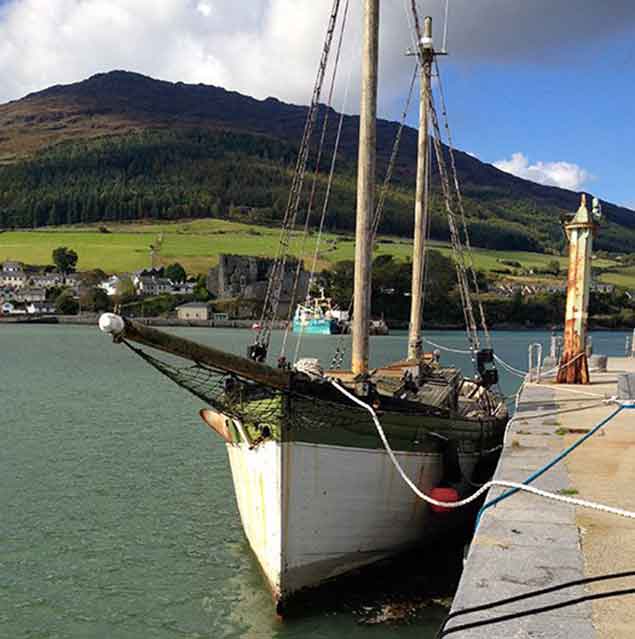 Dreamship? The characterful Silvery Light at Carlingford
Dreamship? The characterful Silvery Light at Carlingford
There’s a vessel called the Silvery Light in Newry, and she inspired those who saw her when she first arrived in Ireland alongside the quay in Carlingford. But now the owner seeks support from whatever source to make her fit to be a sail training vessel – we can only wait and see, for we have some idea of what a monumental task this is.
But in the little village of Portaferry, a tall ship dream has turned into disaster. We’ve carried stories of the sunken 130ft Regina Caelis on Afloat.ie in recent weeks, but things get no better.
Apparently she is owned by someone who bought her from a previous owner for just £1.The previous owner from Northern Ireland had bought her in Scotland, hoping to turn her into a tall ships dream to sail in warmer seas. But by the time he’d got her home to County Down, he realised it was beyond his ability to complete the work, so after he’d managed with great difficulty to get her berthed on the end of the little public quay at the south end of Portaferry, she was offered for sale for the nominal sum.
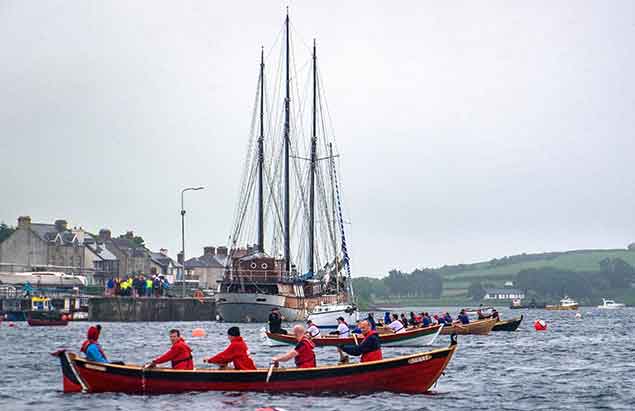 The elephant in the room, The 130ft Regina Caelis overstayed her welcome by many months when she effectively blocked off Cook Street Quay in Portaferry, making it difficult of access for the race officers in one of the local skiffie events, and unusable by any other boats…….Photo: Gary Lyons
The elephant in the room, The 130ft Regina Caelis overstayed her welcome by many months when she effectively blocked off Cook Street Quay in Portaferry, making it difficult of access for the race officers in one of the local skiffie events, and unusable by any other boats…….Photo: Gary Lyons
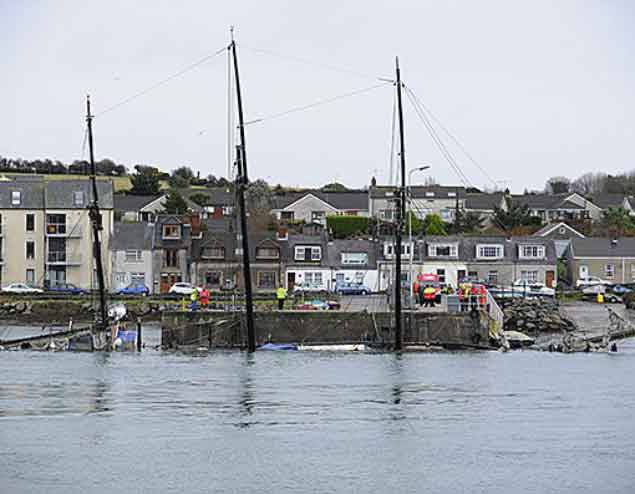 …….and then she went and sank, polluting Strangford Lough with 900 litres of diesel
…….and then she went and sank, polluting Strangford Lough with 900 litres of diesel
That was more than a year ago. Since then she has changed ownership for £1, but she continued to completely block off what should be an important local amenity, as Cook Street Quay – to give it its local name – traditionally provides free berthing, but its successful functioning depends on no-one abusing this valuable privilege.
Whatever about the good intentions when this ship the Regina Caelis arrived at the quay, berthed on it she is so out of scale that her bow sticks out at one end and her stern sticks out at the other, thereby impeding boat access to either side of a public pier. Staying there for more than a year soon became a matter of abusing a communal facility. But then it all became completely pear-shaped when she sank at the pier, gradually leaching 900 litres of diesel fuel into Strangford Lough, a very special nature reserve.
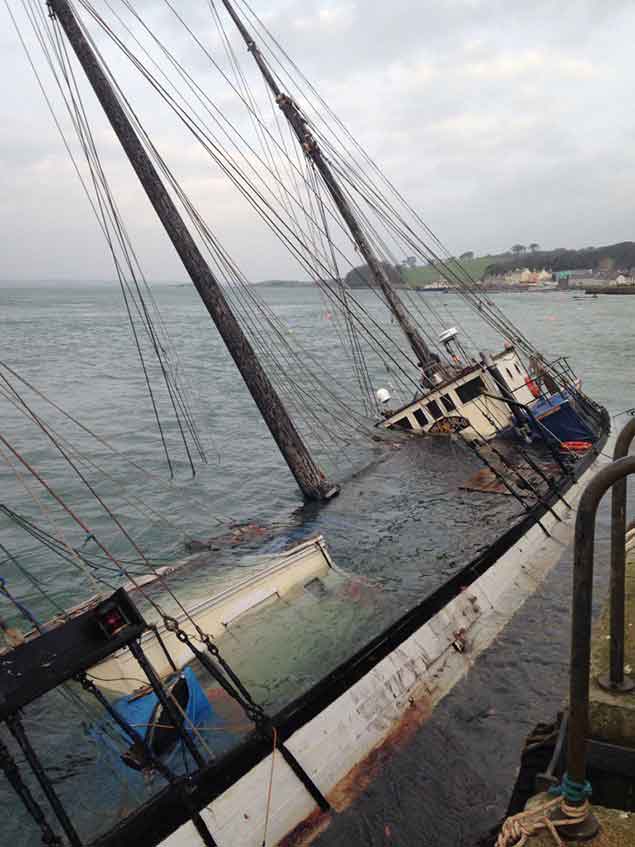 It would provide a perfect course in salvage techniques at some maritime university, but Portaferry could do without it
It would provide a perfect course in salvage techniques at some maritime university, but Portaferry could do without it
It’s now an environmental and neighbourhood disaster beyond belief. But with a free pier and in the absence of an active government, the position has been allowed to persist, while the optimistic owner has launched a crowd-funding initiative in order to raise his vessel and restore her to her full potential as a tall ship.
Seasoned observers reckon that it will indeed be a crowd-funding initiative which will solve the acute problem of the Regina Caelis slowly disintegrating at Cook Street Quay in Portaferry. But the crowd will be the much-put-upon taxpayers of Northern Ireland, and they’ll be in this crowd-funding project whether they want to or not.
Whatever the outcome, it’s all a very long way indeed from a properly researched and resourced sail training barquentine for the young people of all Ireland. And in its veiled hostility, it’s all an extremely long way away from the friendly efficiency of the annual Portaferry Sails and Sound music and traditional boat festival, which shows Portaferry at its best. In every way, it’s an excruciatingly unpleasant situation for a charming village. Portaferry deserves better.
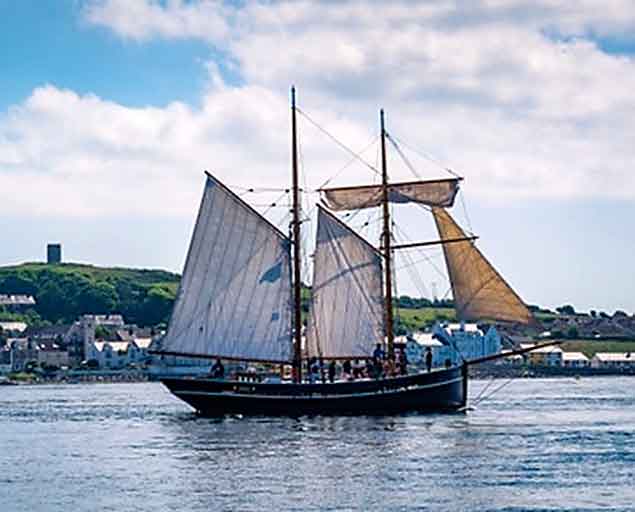 Portaferry in happier times, with Scott & Ruth Metcalf’s schooner Vilma off the town Photo: Neil Ritchie
Portaferry in happier times, with Scott & Ruth Metcalf’s schooner Vilma off the town Photo: Neil Ritchie
Neil O’Hagan Talks Tall Ship Plans, Enda’s Vendée Globe Challenge & More At Greystones SC Next Week
#SailingTalk - The next event in Greystones Sailing Club’s Winter Wednesdays series of talks hosts Neil O'Hagan of the Atlantic Youth Trust, the project that aims to bring about Ireland's next sail training tall ship.
O’Hagan is also on-shore co-ordinator for Kilcullen Team Ireland in the Vendée Globe, and he will have all the scuttlebutt on the highs and lows of Enda O’Coineen sailing Kilcullen Voyager, Ireland’s first entry in the round-the-world solo yachting challenge.
The date for diary is next Wednesday 25 January at 8pm, bar open from 7.30pm. You won’t want to miss it!
Jamie Boag Honoured At Atlantic Youth Trust Gala
#JamieBoag - Volvo Ocean Race team commercial boss Jamie Boag was honoured for his contributions to sailing at the Atlantic Youth Trust's conference and dinner in Galway last weekend, as the Galway Independent reports.
The commercial director of Abu Dhabi Ocean Racing – winners of the most recent Volvo Ocean Race – received the trust's Lifetime Achievement Award for his work with its Irish-flavoured predecessor Green Dragon Racing, as well as his hand in bringing the world's most gruelling ocean yacht race to Galway.
Also on the evening last Saturday (12 March), the Galway Independent contributed €5,000 towards a seed fund to develop a bursary for youth sail trainees in the West of Ireland, along the lines of those already established in Drogheda and West Cork.
The day's conference also saw discussions and workshops on the trust's plans to build a new tall ship for Ireland, as previously reported on Afloat.ie.




























